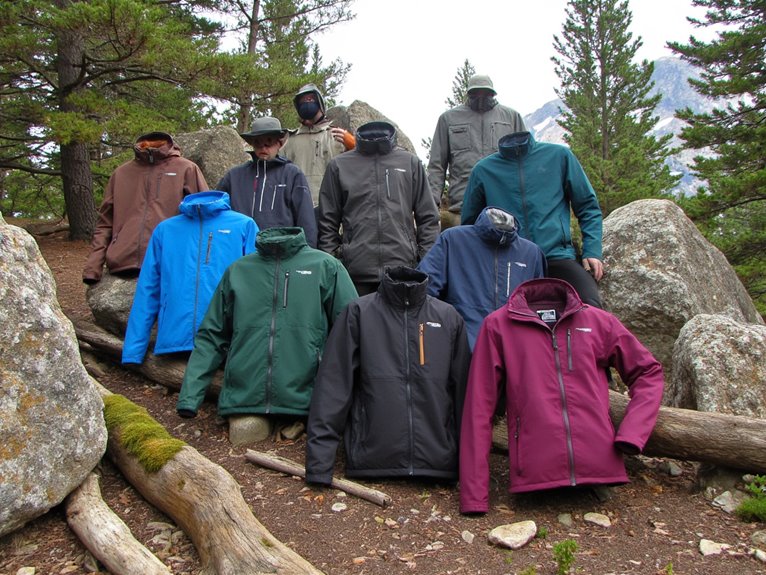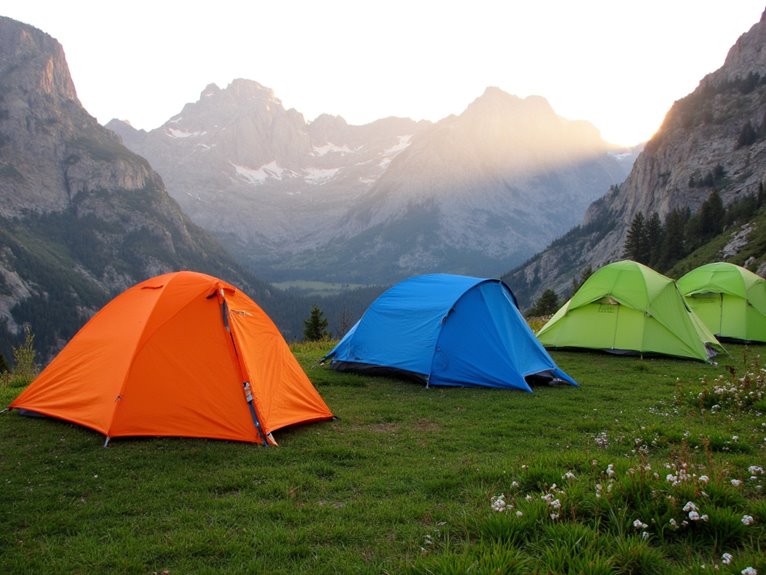Can I Use a Jetboil Inside a Tent?
Operating a Jetboil inside a tent poses significant risks, including carbon monoxide poisoning, burns, and fires, which can be fatal or cause severe injuries. While it may be tempting to use a Jetboil indoors, the risks far outweigh any convenience. To mitigate these risks, proper ventilation is essential, requiring a minimum of two ventilation points and a breathable tent fabric. However, even with precautions, indoor use is still not recommended. For a safer and more informed approach to outdoor cooking, consider the critical factors involved and investigate alternative cooking methods that prioritize safety and efficiency. More important considerations await discovery.
We are supported by our audience. When you purchase through links on our site, we may earn an affiliate commission, at no extra cost for you. Learn more. Last update on 28th December 2025 / Images from Amazon Product Advertising API.
Risks of Indoor Jetboil Use
Operating a Jetboil inside a tent poses significant risks, including carbon monoxide poisoning, burns, and fires, which can be fatal or cause severe injuries.
The confined space of a tent can trap carbon monoxide, a colorless, odorless gas that can be deadly in small concentrations.
Additionally, the open flame of the Jetboil can ignite nearby flammable materials, such as fabrics or gear.
Moreover, the risk of burns is high, as the boiling water and hot stove can cause severe scalds.
Essential to weigh these risks carefully and consider alternative cooking arrangements that prioritize safety.
Ventilation Requirements for Safety
When operating a Jetboil inside a tent, adequate ventilation is vital to create a safe cooking environment.
Fresh air exchange is essential to remove combustion byproducts and reduce the risk of carbon monoxide accumulation.
Failure to provide sufficient ventilation can have serious consequences, making it imperative to implement effective ventilation strategies to mitigate these risks.
Fresh Air Exchange
Proper ventilation is essential to guarantee a safe and healthy environment when using a Jetboil inside a tent, as the combustion process consumes oxygen and releases carbon monoxide and moisture.
Adequate fresh air exchange is necessary to remove these byproducts and maintain a breathable atmosphere.
A minimum of two ventilation points, such as windows or vents, should be provided to facilitate a continuous flow of fresh air.
The tent fabric should also be breathable to allow moisture to escape.
Additionally, positioning the Jetboil in a well-ventilated area, away from sleeping quarters, is imperative to prevent the accumulation of hazardous fumes.
Carbon Monoxide Risks
One of the most critical safety considerations when using a Jetboil inside a tent is the risk of carbon monoxide poisoning, which can occur rapidly and silently, making it essential to prioritize ventilation requirements.
Carbon monoxide is a colorless, odorless, and tasteless gas produced by the combustion of fossil fuels, such as propane.
In an enclosed space like a tent, CO can quickly build up to deadly levels.
To mitigate this risk, guarantee proper ventilation by maintaining a clear path for airflow, opening tent windows or doors, and using a carbon monoxide detector.
Additionally, never use a Jetboil in a sealed or poorly ventilated tent, as this can lead to disastrous consequences.
Carbon Monoxide Poisoning Dangers
When using a Jetboil inside a tent, the risk of carbon monoxide poisoning is a serious concern.
This odorless, colorless gas can quickly accumulate in enclosed spaces, leading to devastating consequences.
It is crucial to understand the dangers of carbon monoxide buildup, silent killer risks, and fatal mistakes that can be made to ensure safe Jetboil operation.
Deadly Gas Buildup
Carbon monoxide, a colorless, odorless, and tasteless gas, can accumulate rapidly inside a tent when using a Jetboil or other fuel-burning appliances, posing a significant risk of carbon monoxide poisoning.
This buildup can occur due to inadequate ventilation, poor air circulation, or blocked exhaust vents.
When carbon monoxide builds up, it can lead to severe health consequences, including headaches, dizziness, nausea, and even death.
It is vital to take preventative measures to minimize the risk of carbon monoxide buildup.
Verify your tent has proper ventilation, and never use a Jetboil or other fuel-burning appliances in an enclosed space without adequate airflow.
Always prioritize your safety and the safety of those around you when camping.
Silent Killer Risks
The risks associated with carbon monoxide poisoning are often underestimated, yet they are potentially lethal and can strike without warning, making it imperative to understand the silent killer's dangers.
Carbon monoxide (CO) is a colorless, odorless, and tasteless gas that can quickly build up in enclosed spaces, causing severe illness or even death.
To minimize the risks, it's crucial to:
Ventilate the area: Ensure good airflow by opening windows, using fans, or installing a ventilation system.
Use CO detectors: Install battery-powered or hardwired CO detectors in your tent to alert you to potential dangers.
Maintain equipment: Regularly inspect and maintain your Jetboil and other equipment to prevent malfunction and CO leaks.
Fatal Mistakes Made
In the pursuit of convenience and warmth, many campers and outdoor enthusiasts unwittingly create a deadly environment, ignoring the silent killer that lurks in the shadows of their tents.
Carbon monoxide poisoning is a significant risk when using a Jetboil or other fuel-burning appliances inside a tent.
Fatal mistakes made by campers include inadequate ventilation, ignoring warning signs, and failing to maintain their equipment.
The consequences can be devastating, with carbon monoxide poisoning causing headaches, dizziness, nausea, and even death.
Prioritizing safety and taking preventative measures is vital to avoid these fatal mistakes.
Always use fuel-burning appliances in well-ventilated areas, and never ignore the warning signs of carbon monoxide poisoning.
Essential safety precautions must be taken to prevent carbon monoxide poisoning, and never underestimate the importance of maintaining equipment and recognizing the warning signs.
Tent Material and Fabric Considerations
Fabric selection plays a critical role in determining the safety and feasibility of using a Jetboil inside a tent, as certain materials can substantially increase the risk of fire hazards or damage to the tent itself.
When evaluating tent material, consider the following factors:
Fabric thickness: Thicker fabrics are generally more resistant to heat and flames, but may compromise ventilation and weight.
Material type: Silnylon, nylon, and polyester are common tent materials, each with varying levels of heat resistance and flammability.
Coatings and treatments: Some tents feature flame-resistant coatings or treatments, which can improve safety when using a Jetboil inside.
Alternative Outdoor Cooking Options
Several alternative outdoor cooking options exist, including portable grills, camping stoves, and overland cooking systems, which can provide a safer and more convenient alternative to using a Jetboil inside a tent.
These options can be more ventilated, reducing the risk of carbon monoxide buildup and fire hazards.
Portable grills, for instance, can be set up outside the tent, allowing for a more traditional cooking experience.
Camping stoves, on the other hand, can be used in a well-ventilated area, providing a more controlled cooking environment.
Overland cooking systems, which often include a stove, cookware, and utensils, can be a thorough solution for outdoor cooking.
Jetboil Manufacturer Guidelines
According to Jetboil's manufacturer guidelines, their portable cooking systems are designed for outdoor use, and the company explicitly advises against using them inside a tent or other enclosed space. This is due to the potential risks associated with indoor use, including carbon monoxide poisoning and fires.
The manufacturer's guidelines emphasize the importance of using Jetboil products in well-ventilated areas, away from flammable materials and overhanging branches.
Key guidelines include:
- Use in well-ventilated areas: Avoid using Jetboil products in enclosed spaces, including tents, to prevent the buildup of carbon monoxide.
- Keep away from flammable materials: Maintain a safe distance from flammable materials, such as dry leaves, twigs, and other combustible items.
- Monitor wind direction: Be aware of wind direction to prevent flames and sparks from being blown towards flammable materials.
Safety Precautions for Indoor Use
While Jetboil's manufacturer guidelines advise against indoor use, there may be exceptional circumstances where using a Jetboil inside a tent is unavoidable, and in such cases, it is imperative to take stringent safety precautions to minimize risks.
Provide good ventilation by opening tent flaps or windows to prevent carbon monoxide buildup.
Place the Jetboil on a heat-resistant surface, away from flammable materials.
Keep a fire extinguisher nearby and maintain a safe distance from the stove.
Monitor the stove's flame and adjust as needed to prevent overheating.
Never leave the stove unattended, and turn it off when not in use.
Weighing the Risks and Benefits
How do the benefits of using a Jetboil inside a tent, such as convenience and efficiency, stack up against the inherent risks, including carbon monoxide poisoning and fire hazards?
When weighing the pros and cons, it's essential to weigh the potential consequences of indoor use. On one hand, a Jetboil can provide a convenient and efficient way to prepare meals in the comfort of your tent.
On the other hand, the risks associated with indoor use cannot be ignored.
Three key factors to examine:
Ventilation: Provide proper ventilation in your tent to minimize the risk of carbon monoxide buildup.
Fire safety: Keep a fire extinguisher nearby and maintain a safe distance from flammable materials.
Alternative options: Explore using a Jetboil outside or exploring alternative cooking methods, such as portable electric stoves or camping grills, and evaluate their feasibility.


